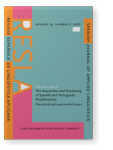Examining L2 acquisition of the Spanish pluperfect subjunctive
Monolingual variation and L1 English learners’ difficulties
There is a strong line of research on mood selection of the Spanish subjunctive (e.g., relative, argument, and adverbial clauses), but little attention has been paid to the Spanish pluperfect subjunctive in second language (L2) acquisition. The main purpose of this study is to investigate the acquisition of the Spanish pluperfect subjunctive in conditional clauses. This study aims to demonstrate what is easier and what is more difficult to acquire, as well as what the results can tell us in terms of interfaces. Forty-five participants (n=24 adult Spanish learners and n=21 native speakers) completed a proficiency test and four linguistic tasks. The results show variation by native speakers in their use of the subjunctive, while Spanish learners had difficulty with the morphology, but not with the semantics or pragmatics. These results are consistent with hypotheses that recognize that difficulty stems from morphology. The findings also suggest that the use of the Spanish pluperfect subjunctive involves multiple interfaces that interact simultaneously at the moment of the morphological realization.
